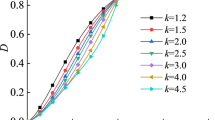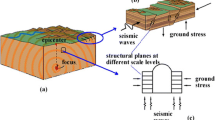Abstract
This study aims to investigate the characteristic energy factor of the deep rock mass deformation subjected to the disturbance induced by excavation or explosion. Based on the well-known rock hierarchical structure, the equivalent average kinetic energy of the deep rock mass under weak disturbance is first introduced. The characteristic energy factor that reflects the instable deformation of the deep rock mass is derived using the principle of variation. The relationship between the characteristic energy factor and the energy hierarchical sequence of the deep rock mass deformation and failure has also been illustrated. We believe that the characteristic energy factor is closely related to the characteristic scientific phenomena of deep rock mass in essence, which can provide a new approach for the study of deep rock mass in the fields of nonlinear mechanics, statistic physical mechanics, and mechanics of explosion and geophysics.


Similar content being viewed by others
Abbreviations
- \( A,B,n,m \) :
-
Coefficients measured in the test
- \( C_{p} \) :
-
P-wave velocity, m/s
- \( C_{R} \) :
-
The cohesive strength between blocks and surface, MPa
- \( f \) :
-
Disturbing force, N
- \( f_{1} ,f_{2} \) :
-
Vibration amplitude, functions of coordinates, N
- \( F_{\delta } \) :
-
The applied force provided by the surrounding rocks, N
- \( F_{\tau } \) :
-
Shear force, N
- \( F_{\text{s}} \) :
-
Resistance of the surface against the rock movement, N
- \( i \) :
-
Level of rock blocks (tectonic elements)
- \( I \) :
-
The impact energy factor
- \( k \) :
-
Dimensionless energy conditions for the appearance of quasi-resonance and pendulum-type waves
- \( k{}_{\delta } \) :
-
Stiffness coefficient of the surrounding rock, N/m
- \( L_{i} \) :
-
Characteristic size of rock blocks at the ith level, m
- \( L_{*} \) :
-
Characteristic size of dissipative structures, m
- \( M \) :
-
Mass of the rock mass at the center of explosion-center, kg
- \( M_{i} \) :
-
Mass of the rock blocks with size of \( L_{i} \), kg
- Q :
-
Explosion equivalent, kt TNT
- \( r \) :
-
Coordinate, m
- \( R(t) \) :
-
The stable motion, m
- \( R_{c} \) :
-
Denotes the strength of the rock under the action of initial geostress \( \sigma_{0} \), MPa
- \( R_{*} \) :
-
The irreversible deformation region radius under large-scale underground explosion, m
- \( R_{\text{cavity}} \) :
-
The radius of the cavity for a large-scale underground explosion, m
- \( R_{\text{crush}} \) :
-
The radius of the crushing zone for a large-scale underground explosion, m
- \( R_{\text{crack}} \) :
-
The radius of the radial cracking zone for a large-scale underground explosion, m
- \( S \) :
-
The interface area, m2
- \( T \) :
-
Compression duration of the compression wave, s
- \( T^{\prime} \) :
-
Period of motion in the stationary field U, s
- \( U \) :
-
Stationary field of high-geostress, J
- \( U_{\text{total}} \) :
-
Denotes the total energy of the system, as shown in Fig. 1b, J
- \( U_{\text{eff}} \) :
-
The effective potential energy, J
- \( U_{\text{s}} \) :
-
The work done by the shear force, J
- \( W \) :
-
Disturbance energy, the average value of the vibration kinetic energy, J
- \( W_{L} \) :
-
The work done by the surrounding rocks, J
- \( \chi \) :
-
Number of the contact surfaces
- \( \delta_{0} \) :
-
Displacement of the surrounding rocks, m
- \( \varepsilon \) :
-
Effective strain
- \( \varepsilon_{*} \) :
-
The critical effective strain as the irreversible deformation appears on the slip surface
- \( \bar{\varepsilon } \) :
-
Equivalent average strain
- \( \mu_{0} \) :
-
Friction coefficient
- \( \mu_{\text{s}} \) :
-
The static friction coefficient
- \( \mu_{\text{d}} \) :
-
The dynamic friction coefficient
- \( \rho \) :
-
Density of the rocks, kg/m3
- \( \sigma_{f} \) :
-
Dynamic stress, MPa
- \( \sigma_{\text{n}} \) :
-
The normal stress perpendicular to the interface, MPa
- \( \sigma_{0} \) :
-
Initial geostress, MPa
- \( \tau \) :
-
Shear strength between rock mass and slip surface, MPa
- \( \upsilon \) :
-
Particle vibration velocity, m/s
- \( \upsilon_{0} \left( r \right) \) :
-
The maximum velocity of the particle vibration velocity, m/s
- \( \upsilon_{*} \) :
-
The maximum velocity of the particle vibration velocity at \( r = R_{*} \)
- \( \omega \) :
-
Frequency of the disturbing force, s−1
- \( \xi (t) \) :
-
Micro-vibration function, m
- \( \varGamma \) :
-
Displacement of the rock block, m
References
Adushkin VV, Oparin VN (2012) From the alternating-sign explosion response of rocks to the pendulum waves in stressed geomedia. Part I. J Min Sci 48(2):203–222
Adushkin VV, Oparin VN (2014) From the alternating-sign explosion response of rocks to the pendulum waves in stressed geomedia. Part III. J Min Sci 50(4):623–645
Adushkin VV, Spivak AA (1990) Characteristic features of the deformation of a block medium during blasting. Sov Min 26(2):142–147
Adushkin VV, Spivak AA (1993) Geomechanics of large-scale explosion. Nedra, Mosocow, pp 25–72
Adushkin VV, Kostyuchenko VN, Nikolaevsky VV, Tsvetkov VM (1973) Mechanics of underground explosion. VINITI, Moscow
Dickey DD, Mckeown FA, Bucknam RC (1972) Preliminary results of ground deformation measurements near the Cannikin explosion. B Seismol Soc Am 6:1505–1518
Guha SK (2000) Induced earthquakes. Kluwer Academic Publishers, The Netherlands, pp 75–181
Jaeger JC, Cook NGW (1963) Pinching-off and Disking of Rocks. J Geophys Res 68(6):1759–1765
Johnson TL, Scholz CH (1976) Dynamic properties of stick-slip friction of rock. J Geophys Res 81:881–888
Kang SS, Ishiguro Y, Obara Y (2006) Evaluation of core disking rock stress and tensile strength via the compact conical-ended borehole overcoring technique. Int J Rock Mech Min 43(8):1226–1240
Kocharyan GG (2013) Fault zone stiffness as a geomechanical factor controlling the radiation efficiency of earthquakes in the continental crust. Dokl Earth Sci 452(1):922–925
Kocharyan GG, Ostapchuk AA (2011) Variations in rupture zone stiffness during a seismic cycle. Dokl Earth Sci 441(1):1591–1594
Kocharyan GG, Spivak AA (2001) Movement of rock blocks during large-scale underground explosions. Part I: experimental Data. J Min Sci 37(1):64–76
Kocharyan GG, Spivak AA, Budkov AM (2001) Movement of rock blocks during large-scale underground explosions. Part II: estimates by analytical models, numerical calculations, and comparative analysis of theoretical and experimental data. J Min Sci 37(2):149–168
Kurlenya MV, Oparin VN (1990) Sign-variable reaction of rocks to dynamic impacts. Sov Min Sci 26(4):291–300
Kurlenya MV, Oparin VN (2000) Problems of Nonlinear Geomechanics. Part II. J Min Sci 36(4):304–326
Kurlenya MV, Oparin VN, Vostrikov VI (1997) Anomalously low friction in block media. J Min Sci 33(1):1–11
Landau LD, Lifshitz EM (1987) Course of theoretical physics. In: Fluid mechanics, vol 6, 2nd edn. Pergamon Press, Oxford, pp 256–321
Landau LD, Lifshitz EM, Reichl LE (2008) Statistical Physics, Part 1 (Third Edition). Phys Today 41(7):58
Lim SS, Martin CD (2010) Core disking and its relationship with stress magnitude for Lac du Bonnet granite. Int J Rock Mech Min 47:254–264
Mckeown FA, Dickey DD (1969) Fault displacements and motion related to nuclear explosions. B Seismol Soc Am 59(6):2253–2269
Qi CZ, Wang MY, Qian QH et al (2007) Structural hierarchy kinetic nature of deformation and fracture of geomedium and seismic forecasting. Chin J Rock Mech Eng 26(s2):4060–4065
Qian QH, Wang MY (2010) Impact and explosion effect in rock and soil. National Defense Industry Press, Beijing, pp 7–30
Sadovsky MA (1979) Natural lumpiness of rocks. Dokl Akad Nauk SSSR 10(4):82–107
Tan TK, Kang WF (1981) Locked in stresses, creep and dilatancy of rocks, and constitutive equations. Int J Rock Mech Min 18(1):4–16
Tullis TE (2015) Mechanisms for friction of rock at earthquake slip rates. In: Schubert G (ed) Treatise on geophysics, 2nd edn. Elsevier, Burlington, pp 139–159
Wang MY, Li J, Li KR (2015) A nonlinear mechanical energy theory in deep rock mass engineering and its application. Chin J Rock Mech Eng 34(4):659–667
Acknowledgments
The authors would like to acknowledge the financial support from the National Natural Science Foundation of China (Grant No. 51527810, No. 51309233, No. 51309234) and the National Basic Research Program of China (973 Program, No. 2013CB036005), which is greatly appreciated by the authors.
Author information
Authors and Affiliations
Corresponding author
Rights and permissions
About this article
Cite this article
Wang, M., Li, J., Ma, L. et al. Study on the Characteristic Energy Factor of the Deep Rock Mass Under Weak Disturbance. Rock Mech Rock Eng 49, 3165–3173 (2016). https://doi.org/10.1007/s00603-016-0968-2
Received:
Accepted:
Published:
Issue Date:
DOI: https://doi.org/10.1007/s00603-016-0968-2





